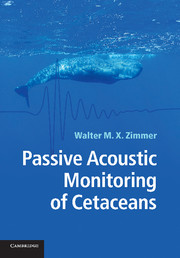Book contents
- Frontmatter
- Contents
- Acknowledgements
- Introduction
- Part I Underwater acoustics (the basics)
- 1 Principles of underwater sound
- 2 Cetacean sounds
- 3 Sonar equations
- Part II Signal processing (designing the tools)
- Part III Passive acoustic monitoring (putting it all together)
- References and further reading
- Index
1 - Principles of underwater sound
Published online by Cambridge University Press: 26 April 2011
- Frontmatter
- Contents
- Acknowledgements
- Introduction
- Part I Underwater acoustics (the basics)
- 1 Principles of underwater sound
- 2 Cetacean sounds
- 3 Sonar equations
- Part II Signal processing (designing the tools)
- Part III Passive acoustic monitoring (putting it all together)
- References and further reading
- Index
Summary
The objective of this chapter is to provide the notation and basic concepts of underwater sound that may be found useful for understanding both the description of cetacean sound and the use of the sonar equation. The approach should be complete enough without going into too much detail, but should provide the basis, in terms of concept and notation, to support the discussion of the remainder of the book. As this chapter can be considered as a general introduction to underwater sound, it synthesizes various textbooks and presents the information in the context of PAM, covering the following subjects:
Sound as a pressure wave and the wave equation
Measuring underwater sound (the decibel scale)
Sound velocity models and profiles
Sound propagation
Sound as an information carrier, disturbance or noise
Sound as a pressure wave
Historically, the term sound was used to describe pressure waves in air and that are audible by humans (Randall, 1951), but in this book, I will follow the recent custom in underwater acoustics and use the word sound to describe all pressure waves that are generated by an initial pressure fluctuation irrespective of frequency and media in which the sound waves propagate.
- Type
- Chapter
- Information
- Passive Acoustic Monitoring of Cetaceans , pp. 7 - 38Publisher: Cambridge University PressPrint publication year: 2011
- 4
- Cited by



